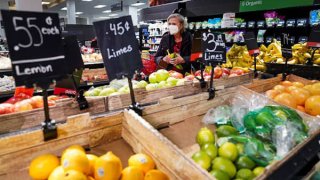
- The consumer price index for January is expected to show headline inflation at the highest pace since 1982, when it is reported Thursday morning.
- CPI is expected to rise by 0.4% or 7.2% year-over-year.
- "I think if this number comes out higher than expected and it pushes the year-over-year number higher than 7.2% that argues further for the Fed to be aggressive in short order," said one economist.
Economists are expecting another hot inflation report, with the headline consumer price index running at a 7.2% pace in January.
CPI is reported Thursday at 8:30 a.m. ET and is expected to show an increase of 0.4%, a slower monthly increase than December, which had a revised headline gain of 0.6%. The year-over-year forecast of 7.2% is the highest since 1982 and is up from 7% in December.
Core inflation, excluding food and energy, is expected to rise 0.4% in January or 5.9% year-over-year, according to Dow Jones. That compares to a monthly increase of 0.6% in December and a year-over-year pace of 5.5% in the final month of last year.
We're making it easier for you to find stories that matter with our new newsletter — The 4Front. Sign up here and get news that is important for you to your inbox.

CPI is key for the markets since inflation is seen as a direct trigger for the Federal Reserve's interest rate hikes, and economists are basing their forecasts for the central bank on how much they think inflation will slow from its rapid pace. The Fed has made clear it will fight inflation, and it is widely expected to raise interest rates multiple times this year, starting with a quarter-point hike in March.
Higher expectations for rate hikes
Money Report
Market expectations for Federal Reserve rate hikes have been moving higher, particularly after the strong January employment report, showing 467,000 payrolls were added in January and revisions of 709,000 jobs in November and December.
"The market took the employment data as the all clear for pricing in more Fed tightening this year. The market's pricing in five or 5.5 hikes," said Tom Simons, economist at Jefferies. "I think if this number comes out higher than expected and it pushes the year-over-year number higher than 7.2% that argues further for the Fed to be aggressive in short order."
But Simons said he expects a below-consensus 0.3% increase in core CPI. "The scenario we envision is when the number comes in somewhat below expectations then you're wondering how the Fed takes that," he said. "If inflation is already rolling over, how much does that motivate them to tighten this year?"
"At the end of the day, I don't think this number is so critical it could change anyone's outlook, but I think the knee-jerk reaction is going to be in that vein," Simons added
A unique path for rising prices
Economists expect the hot annual pace of inflation to peak by March, as the base effects of weak comparisons will end.
The pandemic has made the path of inflation unique in many ways, especially since price gains had been tame prior to 2020. As a result, economists and the Fed are watching to see how inflation ebbs and how much is persistent in the economy.
"I think the message would be it's still another month of strong CPI, but hopefully a little bit less than it was in December and below the recent peaks seen in October," said Michael Gapen, chief U.S. economist at Barclays. "We will be looking in particular for goods prices and used cars."
Economists said January's CPI could show early signs of a trend toward slower goods inflation and more rapidly rising prices in services, including shelter. That is expected to become more apparent as 2022 unfolds.
"There's wage push inflation already here in the services sector, and it's going to accelerate even as supply chain issues and the things [the Fed] thinks are transitory are going to abate," said Diane Swonk, chief economist at Grant Thornton.
She said the perception is services inflation won't rise as dramatically. "But it's hot enough to burn," Swonk added. "Things like rents matter to people, and medical bills are going to go up."
Fading price shocks in some areas
Gapen said some of the pandemic price shocks should start to fade. For instance, he expects the price gains for used cars should be another 2.5% in January, but they should then start to fall off. That compares with a hot pace of 3.5% in December. Used cars prices, as of December, were up 37% year-over-year. In December, the used vehicle price jump accounted for 1.3 percentage points of the 7% CPI rate, he noted.
Supply chain issues should ease as the year goes on, which should directly affect the cost of goods. However, services inflation, fueled by demand and wage gains, should remain elevated at a pace of 4% this year, above a 3% prepandemic level, Gapen said.
"Wages are ripping," said Aditya Bhave, Bank of America senior U.S. and global economist. Wages in December rose 0.7%, or at a 5.7% annually, according to the Bureau of Labor Statistics.
"Wage inflation should continue. It's very hard to find workers, and that's not going away. Labor force participation is still very low. That's a difficult problem to solve," he said.
Bhave said wages and shelter should continue to be a factor in rising CPI. Shelter costs are about 40% of core CPI, and economists expect they will continue to rise.
"For the next several quarters, our hope is price inflation maybe normalizes a little bit as these idiosyncratic factors ease off. We'll get to a point where wages are growing faster than prices, and that will be healthy for the economy," said Bhave.
Gapen said consumer spending is normally 65% on services and 35% on goods. But that shifted during the pandemic with goods services reaching 41% in early 2021. That has since moved back down to 39%.
This helped boost the price of goods, many of which were affected by supply chain issues.
"Within core [CPI], about 75% is services and 25% is goods," Gapen said. "Prepandemic services inflation was running at about 3%, and wages were running 2.5% to 3%. They're now running about 4%. We have services in line with what we're seeing in wage data and rental inflation data."
Shelter costs were up 4.1% year-over-year in December, and economists expect another gain in January.
Where do we land versus the Fed's target?
Bhave also expects a below-consensus 0.3% increase in core CPI for January. He expects inflation to slow but not as much as some forecasters. Bank of America economists also expect an above-consensus seven Fed rate hikes this year.
"We're at 4% Q4 over Q4. That's much lower than where we are now," he said of core CPI. Bhave said his forecast for personal consumption expenditures inflation data, watched closely by the Fed, is for 3% by year end, while the central bank's projections are at 2.6%.
"The bigger question is... where do we land?" he said. "Our forecast suggests we're still significantly above [the Fed target]. That's because of sticky supply chain disruptions as well as cyclical improvements in the economy which should lead to increases in some of the cyclical parts of inflation."
Bhave said both new and used automobiles should be soft in January. Also, travel and leisure prices could have been negatively affected by the omicron Covid variant last month, he said.
Bhave said in January, there could have been less of a bounce in apparel prices, household goods and furnishings than might normally happen in the month.
He said that is due to year-ago comparisons, since retailers did not provide many holiday discounts because of supply issues during the pandemic. "The lack of those discounts means you'll get a smaller bounce than the seasonal factors would suggest," Bhave added.






